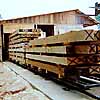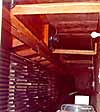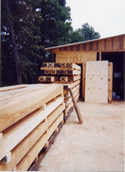
Here at Red Suspenders we are always looking for new ways to make our product better.
By developing the capacity to effectively kiln dry softwood timbers, we have done
just that. What this means to you is that you're assured a timber frame that will
be virtually free of the checking and shrinkage evident in all frames constructed
from green wood. Below is an extensive discussion of the relationship between wood
and water.
Wood vs. Water
In our early years we used only green timber in our frames, as most companies still
do. When wood is referred to as "green," we are not talking about color,
but rather freshly harvested live trees. When a tree is alive, its wood fibers are
saturated with water. When a tree is felled and milled, most of that water remains.
As the water leaves the wood over time, the wood shrinks much as cloth does as it
dries. This shrinkage is often in the range of 10% of a timbers cross section. In
other words an 8" x 8" timber might shrink as much as 5/8" in each
dimension.
In large-dimension timber this drying occurs first in the outer, exposed layers
of the wood. This outer wood starts to shrink as it dries around an essentially
saturated inner core. Since the core will not compress, the wood fibers at the surface
separate and cause what is called a check. These splits, which often run
from the surface of a timber to the heart, can become quite large. We have seen
checks large enough to stick a hand into. Although unsightly, these checks seldom
cause structural problems.
Of more concern to us is the change in cross section mentioned above. It is inevitable
that the joinery in these shrinking timbers will separate somewhat. Draw boring,
or deliberately misaligned the peg holes in the tenon and mortise to draw the joint
tighter, helps somewhat. Even so, we have seen joints that were once so tight that
a piece of paper could not be inserted in them, have gaps large enough to stick
a finger into after 3 or 4 years of drying. We have seen perfectly crafted timber
frames dry and distort to the point that it was hard to tell if anyone paid any
attention to the crafting of the frame in the first place. To our eye, this clearly
is not the best of all possible worlds.
In addition to the problems directly associated with shrinkage of the frame, there
are secondary effects as well. Interior finishes, such as dry wall, that originally
abutted a timber are often no longer in contact with the timber after drying. All
in all long-term quality suffers. There are numerous ways to mitigate these problems
that range from spot patching to waiting until the timbers dry to do finish work.
They all require compromises in quality and added expense.
The real answer to all of these problems is the use of dry, stable wood for the
frame. We were determined to find a way to do it. At first we tried extended air
drying of timbers. This required a great deal of storage room and time. Since wood
dries only about an inch of thickness per year, it took four years to get an 8"
x 8" timber dry through to the core. This was clearly not going to work due to the
time line and expense. Logistics were a nightmare.
|
click to enlarge

Exterior

Timbers Ready to Go In

Interior

Dry timbers
|
Recycled Materials
As an alternative we look to the use of recycled materials. These timbers, salvaged
from old structures have the advantage being dry. When remilled and fashioned into
a frame, they yield the results one might expect. The joinery, after a number of
years, shows the same quality it did when first crafted. Timbers do not shrink or
distort and interior finishes looked as good in five years as they did when first
installed.
This would seem like the perfect solution, and it would be except for several considerations.
The first is availability. It was not always possible to find the timbers needed
for a particular project. Larger timbers must often be sawn into much smaller sizes.
Because of this and other problems, only about half of all salvaged timber ends
up in a timber frame. This adds much to the expense of recycled timbers. In addition,
some of the excess material sawn from old timbers is actually contaminated with
materials such as lead paint and asbestos. This makes them toxic wastes that need
to be disposed of properly. The last problem we see is shipping this stuff in from
all over the continent, while perfectly good timber is available to us, literally
in our own backyard.
Search for a Better Way
All this brought us to our search for a reasonable method of kiln drying new timbers
to a moisture content that would greatly mitigate shrinking and other distortions
of the timber. We were told by many that it couldn't be done or that degradation
of the material would be unacceptably severe. Given the old technology of high temperature
steam kilns, they were right. However, after much research and considerable investment,
we found a method that did yield satisfactory results. A low temperature dehumidification
process is rapid enough to dry timber in a reasonable period of time, is energy
efficient enough to be cost effective, and is gentle enough to cause very little
stress and fiber distortion in the timber.
We built our first experimental kiln in 1996. It worked so well we added a second
in 1998. We plan to add two more in the next few years. As we have become more adept
at operating these kilns, we have been able to dry timbers down to 15% moisture
content virtually from surface to core in about 28 days. We regularly dry Southern
Yellow Pine and have also dried Douglas Fir. This process allows us to use dry,
stable wood in our frames without having to resort to the expense of recycled timber.
Please visit the Board Barn for other kiln-dried materials
we produce.
|